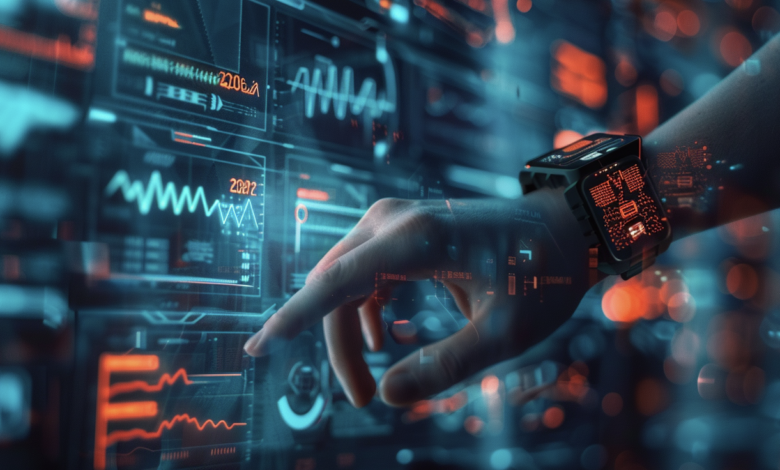Putting the Smart Voice in Smart Devices: The Future of AI-Driven Health Wearables

The release of the new GPT-4o model heralds an era of voice-driven interaction that will quickly move far beyond the typical Siri and Alexa voice experiences that we have become accustomed to. With this next level AI becoming readily accessible, advances in wearable health will increasingly becoming integral to our daily lives, and integrated by easy to use voice prompts. This post explores the pivotal role of AI in this rapidly emerging Anywhere Health integration, highlighting how wearable devices will be transformed by voice-driven AI technology.
The Role of AI in Health Data Integration
AI’s capability to process vast amounts of data swiftly and with precision allows it to identify patterns and insights that would be impossible for humans to detect within a reasonable timeframe. In the context of health data, AI algorithms can analyze inputs from multiple sources, ensuring a holistic view of an individual’s health. This integration enables predictive analytics, where AI can forecast potential health issues before they become apparent, allowing for proactive management rather than reactive treatment.
With the advent of voice-driven AI agents, this integrated data set will finally become readily accessible by both patients and HCPs – allowing for much easier access to insights and suggestions for behavior changes. Looking back, our current set of poorly connected, and silent health devices will seem primitive at best. In the future, AI tools will help give voice to our personal data and related health goals in remarkably personal and timely ways.
Furthermore these AI voices will be:
* Customized in an endless variety of personalities,
* Speak in any language,
* Set for any level of health literacy.
12 Key Wearable Health Devices Enhanced by AI
1. Smart Watches and Fitness Trackers: These devices collect data on steps, heart rate, sleep patterns, and more. AI will integrate this data to provide personalized health insights and recommendations. Your AI voice agent will be available at any time to offer feedback, coaching and even inspiration.
2. Smart Reminders: Beyond tracking fitness, trackers will use AI voice prompts to remind users to take medication and even alert caregivers in an emergency.
3. Smart Rings: Compact and less intrusive, these rings benefit from AI in monitoring sleep and activity to offer suggestions for lifestyle adjustments.
4. Smart Glasses: AI in these devices can offer real-time health insights through augmented reality, enhancing user interaction and adherence to health advice. Voice driven prompts can provide realtime exercise prompts and even in store grocery tips to get healthy food.
5. Smart Clothing: Embedded sensors in clothing provide AI systems with continuous streams of health data, from heart rate monitoring to muscle activity, enabling tailored health advice and alerts. This unobtrusive approach will make the wearing of monitors an easy and integrated part of everyday life.
6. Wearable ECG Monitors: AI enhances these devices by analyzing heart rhythm data to detect abnormalities that may require medical attention.
7. Wearable Blood Pressure Monitors: AI algorithms help predict trends in blood pressure data, offering early warnings of potential health issues.
8. Smart Socks: Particularly useful for diabetics, AI in these socks can detect changes in foot temperature, a precursor to potential complications.
9. Wearable Sleep Trackers: AI uses data from these trackers to provide insights into sleep patterns and advice on improving sleep quality. AI voice prompts can be used before sleep to help set the stage for better sleep, and also be used in the morning to review the sleep cycle with patients.
10. Posture Correctors and Trackers: These devices benefit from AI by learning individual habits and providing customized training and feedback to improve posture. The realtime coaching aspect of voice-driven agents will be particularly useful in this type of physical therapy.
11. Biosensor Patches: These patches send various health data to AI systems, which analyze the information to provide real-time health insights.
12. Wearable Cameras: In healthcare settings, AI can process video from wearable cameras to assist in remote diagnosis and monitoring.
Challenges and Opportunities
While the integration of AI and personal health data offers vast potential, it also presents challenges such as data privacy, security, and the need for robust algorithms that can deliver precise and unbiased results. Moreover, the accuracy of AI predictions depends on the quality of the data collected, which must be continuously safeguarded to ensure user trust and regulatory compliance.
Conclusion
The integration of AI with wearable health devices and AI voice agents represents a significant leap forward in personal health management. By harnessing the integrative power of voice-driven AI, these devices will not only provide real-time insights but will also empower users with proactive health management tools.
As these devices become more seamlessly integrated, the advent of powerful voice technologies will allow these devices to speak to us on a personal level, providing real time coaching and health insights. By understanding and leveraging these technologies, we can look forward to a healthier future where personal wellness is more accessible, personalized, and preemptively managed.




